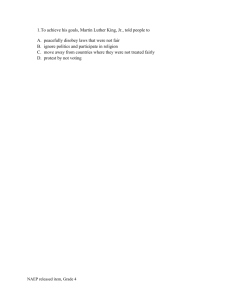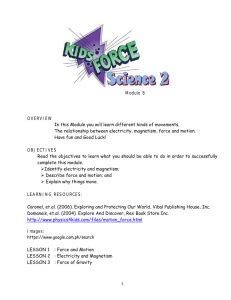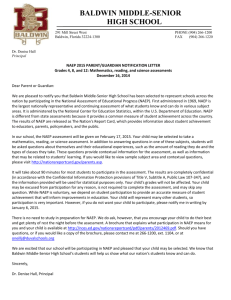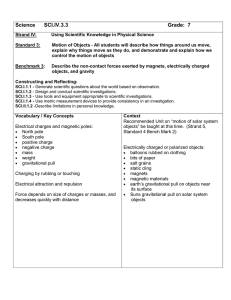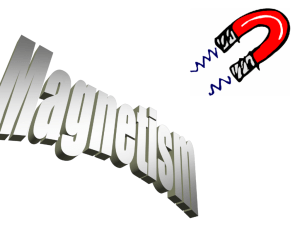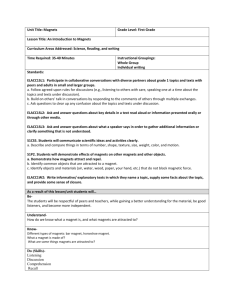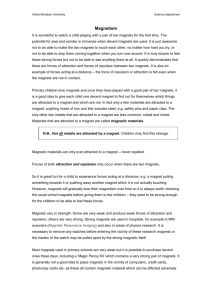E. Forces and Motion
advertisement
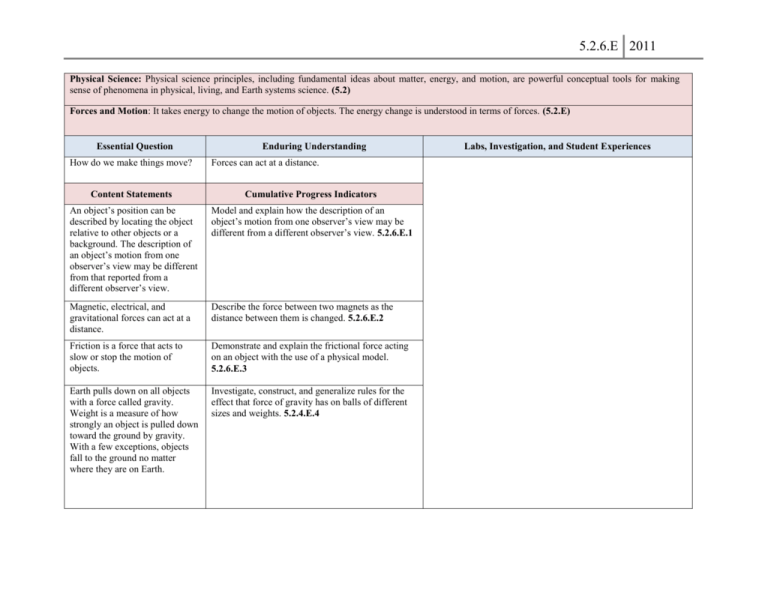
5.2.6.E 2011 Physical Science: Physical science principles, including fundamental ideas about matter, energy, and motion, are powerful conceptual tools for making sense of phenomena in physical, living, and Earth systems science. (5.2) Forces and Motion: It takes energy to change the motion of objects. The energy change is understood in terms of forces. (5.2.E) Essential Question How do we make things move? Enduring Understanding Forces can act at a distance. Content Statements Cumulative Progress Indicators An object’s position can be described by locating the object relative to other objects or a background. The description of an object’s motion from one observer’s view may be different from that reported from a different observer’s view. Model and explain how the description of an object’s motion from one observer’s view may be different from a different observer’s view. 5.2.6.E.1 Magnetic, electrical, and gravitational forces can act at a distance. Describe the force between two magnets as the distance between them is changed. 5.2.6.E.2 Friction is a force that acts to slow or stop the motion of objects. Demonstrate and explain the frictional force acting on an object with the use of a physical model. 5.2.6.E.3 Earth pulls down on all objects with a force called gravity. Weight is a measure of how strongly an object is pulled down toward the ground by gravity. With a few exceptions, objects fall to the ground no matter where they are on Earth. Investigate, construct, and generalize rules for the effect that force of gravity has on balls of different sizes and weights. 5.2.4.E.4 Labs, Investigation, and Student Experiences 5.2.6.E 2011 Desired Results Suppose you are riding in a car along the highway at 55 miles per hour when a truck pulls up along the side of your car. This truck seems to stand still for a moment, and then it seems to be moving backward. 1. Tell how the truck can look as if it is standing still when it is really moving forward. (NAEP) 2. Explain why astronauts on the International Space Station look down at NJ and observe that we are rotating at a speed of almost 795 mph. Explain why you do not feel as though you are moving at all? The picture above shows the positions of two runners at one-second intervals as they move from left to right. 3. For each runner, indicate whether the runner's speed seems to be constant, increasing, or decreasing. 4. Explain how you can tell this from the pictures. 5. (NAEP) To keep a heavy box sliding across a carpeted floor at constant speed, a person must continually exert a force on the box. This force is used primarily to overcome which of the following forces? A. B. C. D. Air resistance The weight of the box The frictional force exerted by the floor on the box The gravitational force exerted by the Earth on the box (NAEP) 5.2.6.E 2011 The picture above shows Maria pushing magnet 1 toward magnet 2, which is lying on a smooth table. 6. What will happen to magnet 2? 7. Why will this happen? (NAEP) 8. Magnets can be toys or tools to do work. Explain how two magnets react when placed near each other. In your explanation, be sure to include the properties of magnets (MD) 9. Two students played on a slide. Student 1 wore shorts, and Student 2 wore long pants. Which of these explanations best identifies why Student 2 moved down the slide more smoothly than Student 1? A. B. C. D. less gravity less friction more weight more acceleration (MD) 5.2.6.E 2011 10. A child at a playground slides down a slide on a windless day. Describe two forces that affect the motion of the child as she moves down the slide. (OH)
